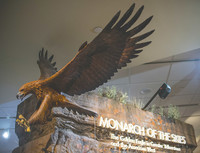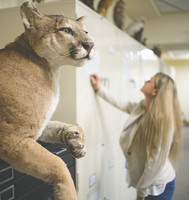Clear and Windy, 35° F
Scientists and assistants at the Draper Natural History Museum at the Buffalo Bill Center of the West were flying high this past weekend.
The celebration of the opening of Monarch of the Skies: …
This item is available in full to subscribers.
The Powell Tribune has expanded its online content. To continue reading, you will need to either log in to your subscriber account, or purchase a subscription.
If you are a current print subscriber, you can set up a free web account by clicking here.
If you already have a web account, but need to reset it, you can do so by clicking here.
If you would like to purchase a subscription click here.
Please log in to continue |
|




Scientists and assistants at the Draper Natural History Museum at the Buffalo Bill Center of the West were flying high this past weekend.
The celebration of the opening of Monarch of the Skies: Golden Eagles of Greater Yellowstone and the American West drew rave reviews from the public, including national researchers of the species.
“We’re in awe of the Draper [Museum],” said Brian Woodbridge, coordinator of the Western Golden Eagle Conservation Team for the U.S. Fish and Wildlife Service. “They’ve really hit the art of exhibit design beautifully — there’s interactive stuff, but it’s not all interactive so you don’t come out feeling overwhelmed. You can sit and look at real eagles. I’m really impressed and I’m still learning about the technology.”
The new permanent exhibit showcases a decade of research by Dr. Charles R. Preston, founding curator of the Draper Natural History Museum and Draper Museum Raptor Experience and his team. It features exhibits demonstrating the iconic predator’s lifecycle, cultural and archeological studies and its habitat in the sagebrush steppe of the Big Horn Basin.
Preston’s work — aided by assistant curators Melissa Hill and Corey Anco, curatorial assistant Bonnie Smith, research assistant Nathan Horton and a “citizen scientist posse” — was inspired by a lifetime of love for raptors and a desire to better understand and protect the species.
“The importance of collaboration is to get ahead of a crisis,” Preston said. “If we take action now, we can avoid the crisis management that we have with so many other species,” Preston said.
The Draper’s research plays an important part in national studies, Woodbridge said. Unlike other habitats, the Big Horn Basin is intact. Many studies are being started where there are big issues, Woodbridge said.
“I don’t know that there’s anywhere that’s stable, but this is about as good as it gets,” Woodbridge said. “Chuck has provided us with tremendous amounts of high quality data that feeds right into our models.”
Building from a big foundation is much better than anecdotal observations, Woodbridge said. And consistency is key. The Draper is the only entity studying the basin’s golden eagles. Others are studying golden eagle movement through the area, but none are studying changes, including harmful invasive species like cheatgrass and its affect on the eagles’ ability to sustain themselves.
“There are few places where there’s a consistent effort. You need a consistent effort to see changes and what’s behind those changes. It’s really important,” Woodbridge said.
The exhibit tells the story of golden eagles in the Big Horn Basin through biological and archeological research, said Smith. She helped curate the exhibit with Preston and Buffalo Bill Center of the West Plains Indians Museum Curator Rebecca West.
“It’s been years in the making,” Smith said. “When the pieces started moving in, it was better than I could ever have imagined.”
A reproduction of an eagle trap, complete with examples of pictographs and petroglyphs, and an authentic feathered bonnet made with golden eagle and grouse feathers and human hair are the highlights of the archaeological pieces.
“We tell the story of the species in the Basin for thousands of years,” Smith said.
Displays were intentionally conceived and designed to move forward with exhibit technology, Preston said. It goes beyond the golden eagle population in the Big Horn Basin, using technology to highlight collaboration with other researchers — featuring studies of the species in eight locations available at a finger touch.
“Chuck [Preston] is a master at collaboration. It’s more important than a lot of folks think. They take a long time to build,” said Woodbridge.
For Preston, the research and education is a labor of love. The new exhibit is located right outside his office in the research laboratory. Museum visitors can watch the team prepare species for research and archives — including a herbarium — if they can take their eyes off the exhibit.
“[Golden eagles] are a charismatic, amazing creature,” Preston said. “They’re a great window into the world.”